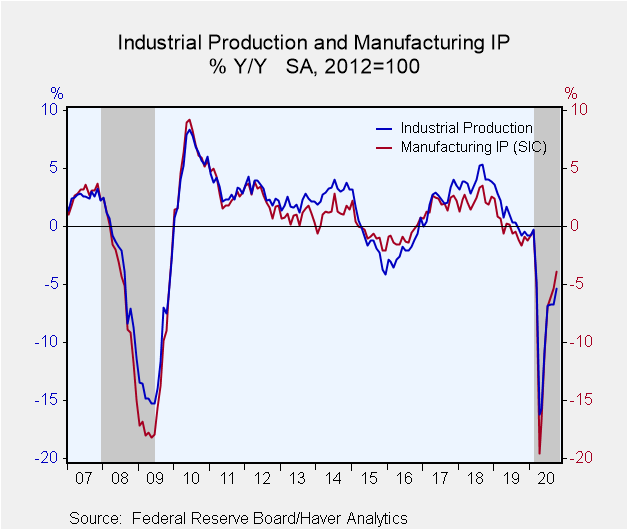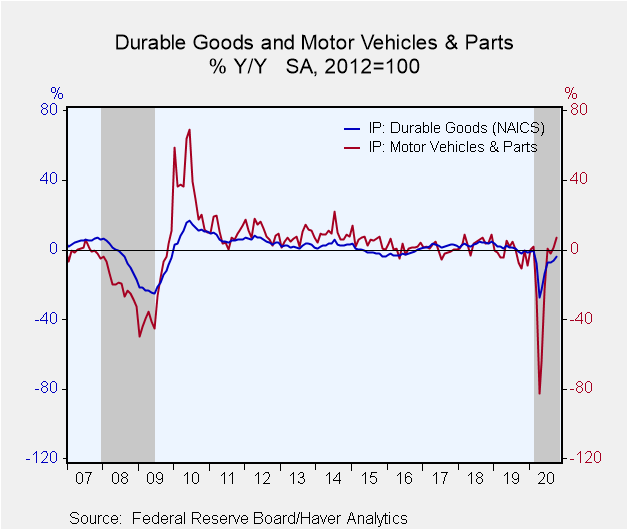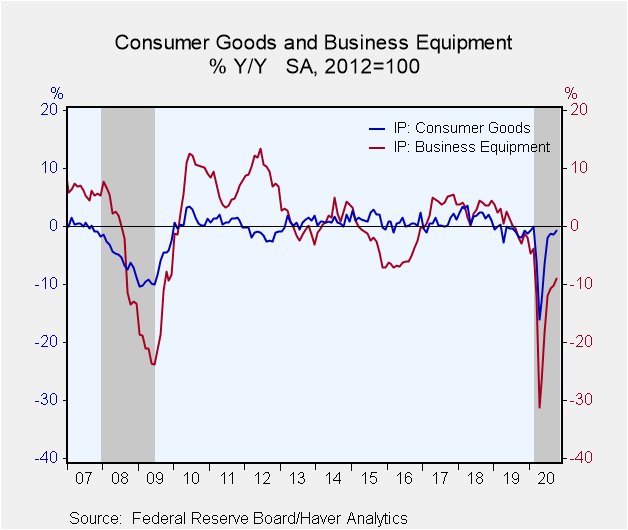 Global| Nov 17 2020
Global| Nov 17 2020U.S. Industrial Production Rebounded in October
by:Sandy Batten
|in:Economy in Brief
Summary
• Industrial production increased 1.1% in October with upward revisions to both August and September. Still, production is 5.6% below its pre-pandemic February level.• Manufacturing led the rebound, rising 1.0% in October with upward [...]
• Industrial production increased 1.1% in October with upward revisions to both August and September. Still, production is 5.6% below its pre-pandemic February level.
• Manufacturing led the rebound, rising 1.0% in October with upward revisions to both August and September.Industrial production rebounded 1.1% m/m (-5.3% y/y) in October after an upwardly revised 0.4% m/m decline in September (initially -0.6%). The Action Economics Survey forecast a 1.0% increase in October. Even with the October increase, industrial production was still 5.6% below its pre-pandemic February level and 6.2% below is most recent peak in November 2019.Manufacturing production led the rebound, increasing 1.0% m/m (-3.9% y/y) in October after an upwardly revised 0.1% rise in September (initially a 0.3% monthly decline). This leaves factory output 4.8% below its February level. Utilities output rose 3.9% m/m (-3.0% y/y) following a 5.2% m/m decline in September. Mining output slipped 0.6% m/m (-14.4% y/y) after a 1.2% m/m increase in September.
The index for durable manufacturing stepped up 0.9% m/m in October, as small drops in the indexes for furniture and related products, fabricated metal products, and motor vehicles and parts were outweighed by gains elsewhere, especially for aerospace and miscellaneous transportation equipment (+2.3% m/m) and for miscellaneous manufacturing (+3.6% m/m). The index for nondurables rose 1.2% m/m with nearly all of its components posting gains.
Every major market group posted gains in October. The output of consumer goods rose 0.8% m/m with broad-based gains among its components. After falling more than 17% between February and April, the index for consumer goods production has rebounded strongly and in October was within 1.7% of its February level. The production of business equipment increased 0.6% m/m (-8.9% y/y) in October, but it was still 7.3% lower than it was in February. The indexes for defense and space equipment, construction supplies, business supplies, and materials each advanced 1.0% m/m or more in October.
Capacity utilization rose to 72.8% in October from an upwardly revised 72.0% in September, but still, well below the 76.9% in February and 79.6% cyclical peak in November 2018. The Action Economics Survey expected an increase to 72.1% in October. Factory sector use also rose in October, to 71.7% from an upwardly revised 71.0% in September versus 75.2% in February and the cyclical peak of 77.3% in December 2018.
Industrial production and capacity and oil prices are located in Haver's USECON database. Additional detail on production and capacity can be found in the IP database. The expectations figures come from the AS1REPNA database.
| Industrial Production (SA, % Change) | Oct | Sep | Aug | Oct Y/Y | 2019 | 2018 | 2017 |
|---|---|---|---|---|---|---|---|
| Total Output | 1.1 | -0.4 | 0.7 | -5.3 | 0.9 | 3.9 | 2.3 |
| Manufacturing | 1.0 | 0.1 | 1.4 | -3.9 | -0.2 | 2.3 | 2.0 |
| Durable Goods | 0.9 | 0.1 | 1.0 | -4.2 | 0.7 | 3.4 | 2.2 |
| Motor Vehicles | -0.1 | -3.0 | -3.7 | 6.9 | -2.4 | 4.1 | 0.0 |
| Selected High Tech | 1.7 | 0.9 | 0.6 | 6.2 | 5.1 | 6.4 | 2.6 |
| Nondurable Goods | 1.2 | -0.1 | 1.8 | -3.0 | -0.7 | 1.9 | 1.9 |
| Utilities | 3.9 | -5.2 | -1.7 | -3.0 | -0.8 | 4.4 | -0.8 |
| Mining | -0.6 | 1.2 | -1.2 | -14.4 | 7.1 | 12.4 | 7.4 |
| Capacity Utilization (%) | 72.8 | 72.0 | 72.2 | 77.0 | 77.8 | 78.7 | 76.5 |
| Manufacturing | 71.7 | 71.0 | 70.9 | 74.6 | 75.6 | 76.6 | 75.1 |
Sandy Batten
AuthorMore in Author Profile »Sandy Batten has more than 30 years of experience analyzing industrial economies and financial markets and a wide range of experience across the financial services sector, government, and academia. Before joining Haver Analytics, Sandy was a Vice President and Senior Economist at Citibank; Senior Credit Market Analyst at CDC Investment Management, Managing Director at Bear Stearns, and Executive Director at JPMorgan. In 2008, Sandy was named the most accurate US forecaster by the National Association for Business Economics. He is a member of the New York Forecasters Club, NABE, and the American Economic Association. Prior to his time in the financial services sector, Sandy was a Research Officer at the Federal Reserve Bank of St. Louis, Senior Staff Economist on the President’s Council of Economic Advisors, Deputy Assistant Secretary for Economic Policy at the US Treasury, and Economist at the International Monetary Fund. Sandy has taught economics at St. Louis University, Denison University, and Muskingun College. He has published numerous peer-reviewed articles in a wide range of academic publications. He has a B.A. in economics from the University of Richmond and a M.A. and Ph.D. in economics from The Ohio State University.










